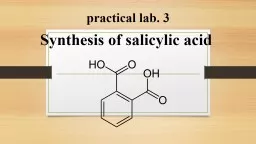

Theory salicylic acid is prepared from methyl salicylate by hydrolysis of ester group with aqueous alkali NaOH or KOH Salicylic acid is a monohydroxybenzoic acid a type of phenolic acid and a beta hydroxy acid This colorless crystalline organic acid is widely used in organic synthesis an ID: 784684
Download The PPT/PDF document "practical lab. 3 Synthesis of salicylic ..." is the property of its rightful owner. Permission is granted to download and print the materials on this web site for personal, non-commercial use only, and to display it on your personal computer provided you do not modify the materials and that you retain all copyright notices contained in the materials. By downloading content from our website, you accept the terms of this agreement.
Slide1
practical lab. 3
Synthesis of salicylic acid
Slide2Theory:
salicylic acid is prepared from methyl salicylate by hydrolysis of ester group with aqueous alkali (NaOH or KOH). Salicylic acid is a monohydroxybenzoic
acid, a type of phenolic acid and a beta hydroxy acid. This colorless crystalline organic acid is widely used in organic synthesis and functions as a plant hormone. It is derived from the metabolism of
salicin
.
Slide3-There are two types of derivatives of SA depends upon the attack on which group takes place
a. Esters of carboxylic acid. b. Substitution of phenolic groups. -Most of these derivatives are introduced to minimize the gastric disturbances, hemorrhage irritation and undesirable taste.
-The advantage of these derivatives is to increase the effects and decrease side effects.
Slide4Examples:
Ammonium salicylate.Sod. Salicylate .Methyl salicylate.
Ethyl salicylate .
Strontium salicylate (sod.
Salicylate+bismuth
nitrate) .Salicylamide.Salysal (ester linkage between two molecules of SA sal-ester-sal)
8
.Acetyl salicylic acid.
Slide5Salicylic acid has strong antiseptic and germicidal properties ; therefore, it's used as preservative material for foods and pharmaceuticals. In addition, it has good treatment of warts , corns and athlete's feet.
Internally , although it shows antipyretic and analgesic activities, its salts and derivatives are used for these purposes.
Slide6Salicylic acid and acetyl salicylic acid:
Salicylic acid was a good analgesic and antipyretic, but it has an unwanted teste and an irritating effect on the stomach, people could not tolerate taking SA. SA was treated with acetic anhydride in the presence of H2
SO
4
to give acetyl salicylic acid (ASA), this compound is known as aspirin tested as better and much less acidic than SA; so that the patient could tolerate taking aspirin by mouth.
Slide7Differences between SA and ASA:
1. SA gives +ve result with ferric chloride FeCl3 because it contains free OH
gp
., while ASA give –
ve
result because (OH) gp. Of SA is acetylated to give ASA.
Slide82. SA can not be used internally because it causes stomach irritation while ASA is less irritating.
3. Melting point of SA differs from that of ASA.4. Salicylate anion is stabilized by intramolecular H bonding; therefore, SA is more slightly soluble in water than ASA (SA<ASA).
Slide9Preparation of salicylic acid
:Lab. Method ( alkaline hydrolysis of ester ): SA is prepared from methyl salicylate by hydrolysis of ester group with aqueous alkali (NaOH or KOH)
Slide10The mechanism :1. Nucleophilic addition of OH- ion to the carbonyl
gp:
2
. Proton transfer to anionic form of tetrahedral intermediate
:
Slide113. Dissociation of tetrahedral intermediate:
Slide124. Proton transfer yields an alcohol and carboxylate anion: